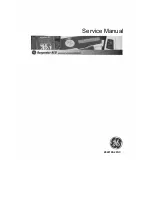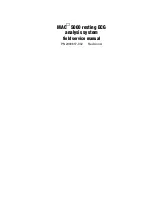
Figure 1a
Figure 1c
Figure 1b: Mounting holes detail as marked
on surfaces
Ceiling mount - drill holes on the face as shown
Wall mount
Cantilever mount
Figure 2: Mains connection and how to get access to main frame
Neutral Earth
Active
Figure 3: Frame insertion diagram
Insert here
to remove
Cable entry holes
Terminal block
Installation instructions
Important: A M6 torx screw driver or drive bit is required for the installation.
1.
Remove four (4) M6 x 1/2 torx pin screws that secure the side cover by using a torx pin driver. Then
gently insert a small flat head screwdriver into the gap between the side cover and the main housing
and lever the side cover out from the housing. See figure 2.
2.
Loosen the thumb screws to remove the side diffusers. Leave the bottom diffuser on.
3.
Remove the fitting from the bracket by gently inserting a small screwdriver into the slot (at ‘D’ in
figure 3) on the front of the bracket towards the right hand end of the fitting to ease the locking tab
into the fitting and away from the bracket. The fitting is then free to slide to the right along the
bracket for about 50mm, at which time the slots line up and it can be lowered away from the bracket,
allowing the two to separate.
4.
Determine the mounting configuration and position, ie: ceiling, wall or cantilever mounting. Drill 4 x
9mm diameter mounting holes at the positions as shown in figure 1a, 1b or 1c depending on
mounting configuration. All drilling locations for mounting holes are indicated on the metal housing
by dimple features. Cable entry hole for wall mounting must be drilled through the polycarbonate
panel and cantilever mounting is drilled to suit anywhere on the face (figure 1c), cable entry hole for
ceiling mount must be drilled at the dimple at the centre of the top face, marked A as shown in figure
1a. Due to the wide variety of building construction materials, mounting screws are not provided with
the fitting. Use appropriate hardware to suit the individual installation and structural support needs
of the fitting. Remove the terminal block cover from the terminal block before mounting the housing
to the wall or ceiling.
5.
After securing the main housing to the wall or ceiling, run the cables through the cable hole into the
bracket, ensuring that the cabling is suitably protected as it passes through the cable entry holes.
Strip, connect and terminate the cables as indicated in figure 2. Ensure that any double insulation of
the cable/s passes into the terminal block area so that no single insulation is exposed when the cover
is in place. Be careful with multi-strand conductors that all of the strands are twisted together before
inserting into the terminal block. Re-install the plastic panel over the terminal block.
• Maintained fittings are
designed for permanent
illumination: connect
incoming unswitched active,
neutral and earth to terminal
marked USA, N and E
respectively.
6.
For Nexus LX product; refer to data connections section.
Data connections
Nexus LX fitting
• The same colour wire from each data cables
connects to the terminal .
• The other colour wire from each of the data
cables connects to the terminal marked -.
• When connected, replace the terminal block
cover so that it clicks and locks into place.
• No mains or mains carrying cables are to be
connected to the data terminals or cables.
7.
Insert the side diffusers and appropriate pictograph inserts and tighten the thumbscrews by hand
(inserts are fitted in between the clear polycarbonate outer panel and the opal acrylic inner panel).
Attach the fitting to the mounting bracket by aligning the top left hand end of the fitting (the end
without the protruding electrical connecting metal lugs) with the large cut-away slot towards the left
hand end of the bracket. Slip the left hand end of the fitting up into the slot in the left hand end of
the bracket (step (1) in figure 3) and hold the fitting horizontal to and parallel with the bracket. It
should be approximately 50mm to the right of its final destination. Simply slide the fitting (step (2) in
figure 3) 50mm to the left along and into the bracket to engage the connection and the locking tab.
Once in place, the fitting cannot be removed from the bracket without the use of a tool (a small
screwdriver) to push in the locking tab at ‘D’ in figure 3.
8.
Once powered up, the normal AC LED lamp should energise and remain lit until the power supply fails.
The emergency function of the light fitting should only operate when the normal lighting power
supply fails or when somebody presses the manual test button located on the side of the fitting.
Normal status of the fitting when powered, red LED indicates that the power is connected and the
battery is charging or when commissioned on the Nexus LX/RF network and the fitting receives
command from the Nexus LX/RF controller to switch into emergency mode. Normal initial
uncommissioned status of the indicating LED on the fitting is flashing green. Once commissioned,
the LED changes to a steady red and flashes red during test. Refer to the Nexus user and technical
guide for a full detailed description of all possible LED states and their meanings.
9.
Check operation of the fitting to ensure that the installation was successful. When powered up, allow
a few minutes to give the battery a small charge, then press the manual test button located at the top
right hand side edge of the fitting. Hold the test button in for a few seconds and observe the
operation of the lamp switching from mains to the emergency mode. If the lamp on emergency mode
works momentarily, that’s okay. Try again in a few more minutes because if the battery was
completely discharged, it may take a little time to charge up enough to operate even momentarily.
After this time, press the test button again and if the lamp does not work at all, check the supply, the
connections and the troubleshooting guide at the end of this document.
10.
If the function test is successful, the end cover can be fitted. Check and adjust the gasket on the end
cover, make sure it is sitting flush on the edge. Fit the end cover to the enclosure and secure it in
place by four (4) M6 torx screws.
Important: 24 hours is required to allow the fitting battery to reach full capacity, ie: prior to a
discharge test. As the installer, it is your responsibility to conduct the initial discharge testing of
the installed fitting. Refer to AS/NZS 2293.
Removal instructions
1.
See steps 2 and 3 in the installation instructions.




















